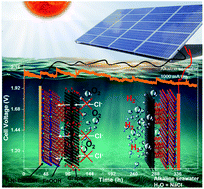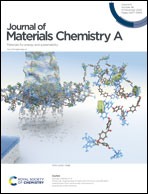Stable complete seawater electrolysis by using interfacial chloride ion blocking layer on catalyst surface†
Abstract
Seawater is the most plentiful natural resource we have on earth and new research is looking at seawater as an alternative to freshwater for hydrogen production by electrolysis. However, the selective electrochemical anodic oxygen evolution reaction from seawater is challenging because of the competitive chloride oxidation reaction as well as anodic corrosion. Here we report an FeOOH deposited β-Ni–Co hydroxide as a new active material with an outer graphene oxide layer, which works effectively for selective overall alkaline natural seawater splitting, which requires very low cell voltages of 1.57 and 2.02 V to reach current densities of 20 mA cm−2 and 1000 mA cm−2, respectively, at 27 °C. Importantly, this electrolyzer shows exceptional stability for more than 378 h at a current density of 1 A cm−2. This discovery can be generalized with other reported unstable OER/HER seawater splitting electrocatalysts, which can significantly progress the expansion of seawater electrolysis for extensive hydrogen production.



 Please wait while we load your content...
Please wait while we load your content...